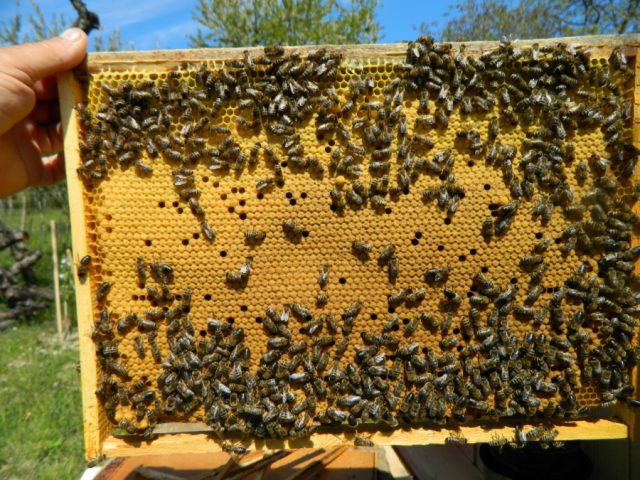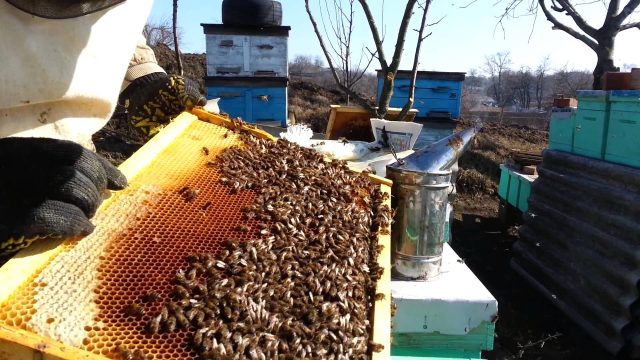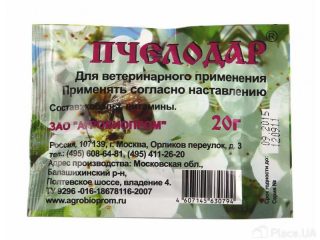Content
September is the first autumn month. At this time it is still quite warm outside, but you can already feel the approach of the first cold weather. In September, bees gradually begin to prepare their hives for winter. As a rule, in August, beekeepers assess the condition of the colonies, carry out preventive treatment against diseases and provide fertilizing. By the first days of September, insect feeding should be completed.
What kind of work is done with bees in August?
Work in the apiary after pumping out honey in August is of great importance.During this period of time, a large amount of work is done to prepare bee colonies for wintering, as a result of which the insects next year will not be weakened and will be able to fully begin work. During August, beekeepers should assess the condition of the colonies, pump out honey, and also begin giving sugar syrup to insects as a feed. In addition, it is necessary to identify theft and, if any, prevent it in a timely manner. This work must be completed by the end of the month.
Assessment of the condition of bee colonies
A scheduled audit is required in August. For inspection, it is recommended to choose a sunny and windless day. During the inspection, the beekeeper must:
- assess the strength of a bee colony;
- check the amount of feed reserves for the winter.
During the inspection of bee colonies, half of the honeycomb frames are removed. There should be 2-3 full frames left, incomplete and damaged ones must be removed. If you leave excess in the hives, they will eventually begin to become moldy, and rodents may become infested. Those honeycombs that are infested with insects should be left.
Pumping out honey
Also in August it is necessary to pump out honey. When pumping out the finished product you will need:
- choose a bright room for work;
- Bees and wasps should not have access to the room.
The algorithm of actions is as follows:
- Carefully open the honeycomb, removing the wax. A knife or fork is suitable for these purposes.
- The prepared frames are sent to the honey extractor. To maximize the honey yield, you need to turn the frames over several times.
- The next step is to pour the finished product through a sieve into a clean container.
Some beekeepers advise allowing the honey to sit for 2-3 days, then removing wax particles and foam, and only then pouring the honey into containers for further storage.
How and what to feed bees in August
Insects in the apiary at the end of August need to be additionally fed. Sugar syrup is used as a top dressing, which is pre-diluted with clean boiled water in equal proportions. The finished syrup is poured into wooden feeders, which are installed in the hives. It is recommended to give about 0.5-1 liters of the finished product for each family.
Milk can be used as a protein supplement. To stimulate growth, tinctures based on pine needles, wormwood, garlic and yarrow are added. On an industrial scale, special additives can be used.
Fight against theft
Many beekeepers compare the theft of bees to a fire. Preventing theft is quite simple if you take preventive measures. The most important thing is to eliminate all the cracks in the hive so that the bees are not tempted by the smell of nectar, while the size of the entrance is reduced to such an extent that one individual can fly into it.
It is recommended to introduce sugar syrup and inspect families in the evening. All work should be carried out as quickly as possible, and stains of syrup and honey should not be left near the hive.
Treatment of bees in August
Caring for bees in August involves treating insects against possible diseases. The most common disease is the attack of bee colonies by mites.In August, during the preparation of insects for wintering, it is recommended to use drugs that will rid the bees of mites. Timely preventive measures can protect the family and prevent the number of deaths in winter.
Preventive treatment of bees in August
Work at the apiary in August includes not only inspection of bee colonies and feeding, but also preventive measures to prevent diseases. It is important to understand that the mite loves moisture, which is why it is recommended to raise the hives on special stands 50 cm high.
For preventive purposes, it is recommended to treat insects from the first days of August for 30 days. Thanks to such manipulations, it is possible to clear bees of mites by almost 90%.
Reduction of bee nests in August
Before you start feeding bees in August, it is recommended to first reduce the nests. To do this, the beekeeper must remove honeycomb frames from the beehive that are not occupied by insects. The first step is to remove frames that are subject to discarding. It is important to understand that the left frames should be half filled with honey or 2/3 full. Having such supplies for the winter, the family will not die of hunger. Honey should be located at the point where the insects are located.
Is it possible to wax in August?
As a rule, foundation is given to bees in the spring, when gardens and dandelions begin to bloom. During this period of time, the honeycombs are not deformed from the heat, the swarming state has not occurred in insects, as a result of which the likelihood of converting bee cells into drone cells is minimal.
An important condition is the presence of a bribe and the bringing of fresh pollen to the hive. It is important to understand that sugar syrup is not able to solve this problem.Without a bribe, insects will not rebuild the foundation.
Work in the apiary in September
The importance of working with bees in September is due to the fact that during this period of time insects begin preparing for wintering. The work carried out in the apiary can be divided into several stages:
- Procuring and providing bee colonies with the necessary amount of nutrition for the winter.
- If insects will spend the winter outside, it is necessary to first insulate the hives.
- In addition, it is necessary to carefully examine the bees and track any theft in the apiary.
Only after this work has been carried out can insects be sent for the winter.
Do bees collect honey in September?
In September, honey collection stops, and the process of preparation for wintering begins. At this time, beekeepers extract most of the honey, leaving a few frames half full. As a feed, the insects receive sugar syrup, which they process throughout September. If the bees have not collected honey before September or it has been completely extracted, there is a possibility that the colony will die due to lack of food.
How much brood should there be in September
Bee colonies that do not yet have brood by the end of August or young queen bees have just begun laying eggs will remain very weak by winter without being connected to other stronger colonies. The number of brood in September should be at least one frame of all ages. It is recommended to first inspect each frame and determine the quality and quantity of honey. White combs that did not contain brood are removed.
Can bees swarm in September?
As practice shows, swarming is possible in September.There are many reasons for swarming, the most important being the absence or death of the queen bee. In addition, the place where honey is collected can be treated with chemicals, which repels insects and forces them to go in search of a suitable place. Another reason why insects may begin to swarm is the absence of a body of water in close proximity to the apiary.
Caring for bees in September
As practice shows, caring for insects is quite difficult. In the autumn period, it is recommended to carry out care up to 6 times; you should not disturb the bees quite often.
Insect care includes:
- provision of feed supplies;
- insulation of hives;
- disease prevention;
- preparation for wintering;
- maintaining a suitable temperature.
With proper care, you can count on a strong bee colony that will produce large amounts of honey.
Inspection of bee colonies in September
It is recommended to inspect all bee families in September, which will determine their strength. If during the inspection weak unproductive families are identified, then they should be discarded. It is also worth identifying those families that need to unite with stronger ones. If sick insects are discovered, it is recommended to immediately begin treatment, as there is a high probability of losing the entire family.
Feeding bees in September
There should be up to 3 kg of honey left for each bee stash. As practice shows, for 8 framed frames you need 25 kg of summer honey. All work must be completed before September 5th, otherwise the bees will not have time to process the syrup into honey.
Particular importance must be attached not only to the quantity, but also to the quality of the honey used. An excellent option is a light variety of honey.It is not recommended to use quickly crystallizing varieties. In addition, insects are given sugar syrup and bee bread.
Removal of honeydew honey
When assembling bee nests in September, it is recommended to remove honeydew honey. As a rule, such honey has a dark brown tint, tastes like spoiled caramel, and has a thick consistency. Insects practically do not digest such honey and in most cases die. When removing honeycomb frames, it is recommended to get rid of such honey first.
Bee processing
At the end of September, bees are treated for varroa. It is recommended to carry out the treatment early in the morning, before the bees begin to fly. For these purposes, you can use Vetfor paper strips. The work is carried out as follows:
- Close the entrance.
- Attach the strip to special holders.
- Place it in the middle of the hive, in the hole between the frames.
You can see the results literally in 30-40 minutes. Almost 80% of ticks will fall off, the rest will die within 12 hours.
Formation of hives in September
The process of formation of bees at the end of September involves the unification of several families:
- All work must be completed by the 18th or by the deadline of September 20th, in the evening.
- Families are formed in good weather.
- Before combining several families, it is recommended to pre-feed the insects.
- It is recommended to place the queen of the hive under a cap for a while.
- Weak families must be united with a strong swarm.
It is important to understand that sick bee colonies cannot be united.
Why do bees fly away in the fall?
Scientists believe that the autumn gathering of insects is due to improper living conditions.If bees begin to leave the hives in September, these may be due to the following reasons:
- death of the queen bee - the brood has not appeared, tired bees begin to fly;
- herbicides - harmful chemicals that are used to treat fields, as a result of which bees begin to look for a cleaner place to live;
- the nest is located incorrectly - for example, the hive is constantly hot or, conversely, cold; in addition, the problem may lie in a body of water, which is located quite far away;
- poor quality material was used in the manufacture of the nest;
- beekeepers feed insects, as a result of which the bees do not have enough space to build a common nest;
- constant transportation of a swarm from one place to another.
If the bees begin to swarm and prepare to fly, then it is necessary to find out the reason for this and eliminate it immediately.
Working with hives in the apiary in September
In September, insulation work is carried out in the apiary. If the nest does not occupy the entire space, then the sides of the housing should be covered with boards. As a result, the impact of cold winds will be smoothed out. Insulation and dry moss are placed into the existing cracks and finally sealed with a special pillow. If you plan to use hay or any other dry grass for insulation, then you should make sure that there are no seeds.
Conclusion
In September, bees begin the process of preparing for wintering, which is why it is so important to give them due attention during this period of time. Beekeepers must inspect colonies to identify infected and weakened individuals. They must be cured and subsequently united with a strong family.In addition, it will be necessary to treat the insects and provide them with the necessary amount of food, which will allow the bees to survive the winter fully and without loss.











